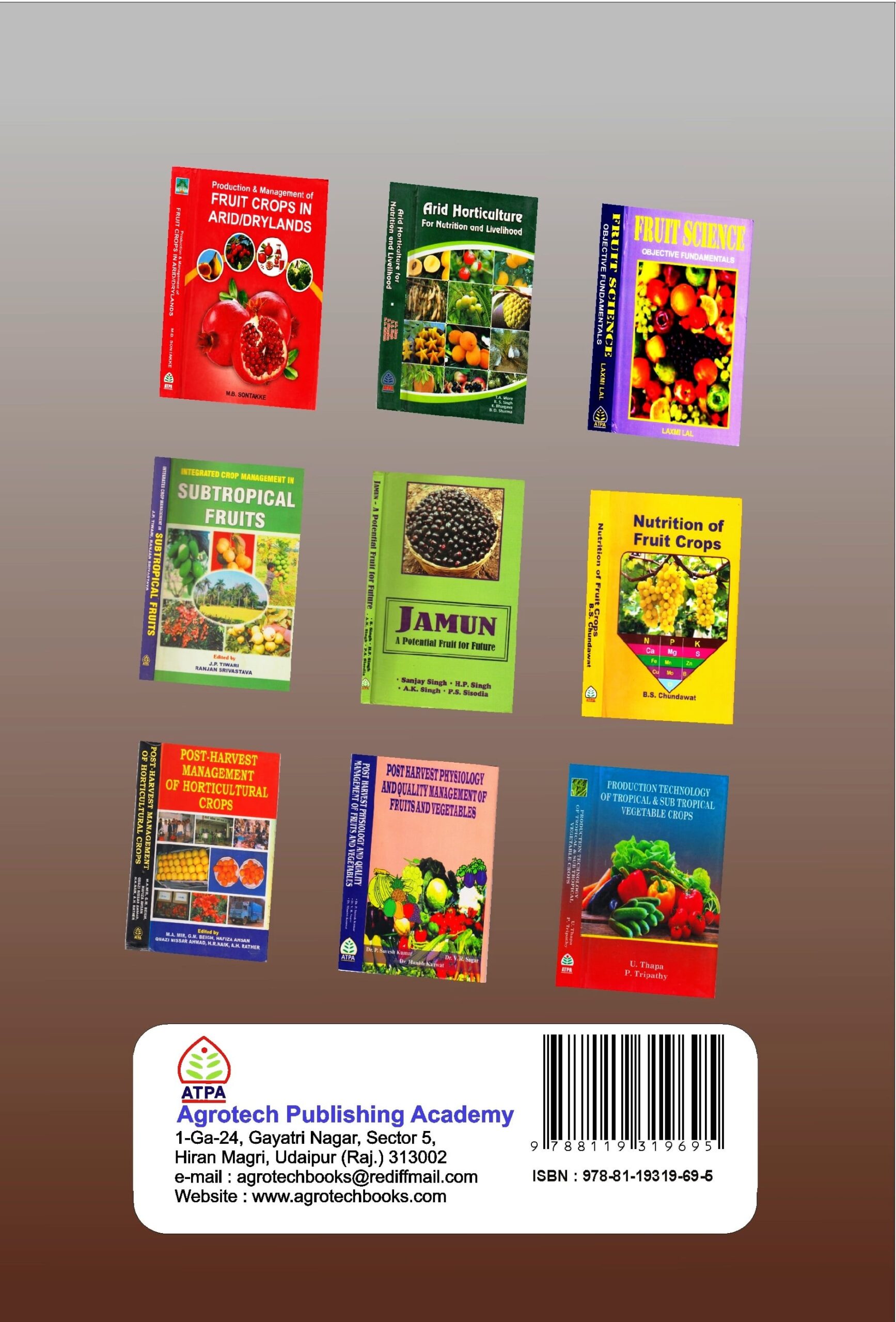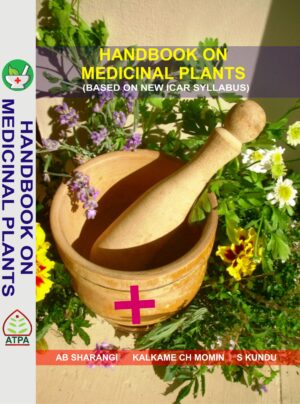METHODS OF BACTERIAL PLANT PATHOLOGY
₹1,089.00
AUTHOR: B.P. CHAKRAVARTI
PUBLISHING YEAR: 2024
EDITION: 2nd
ISBN: 9788119319695
© All Rights Reserved
Description
CONTENTS
| Title | Page | |
| Preface | 4 | |
| Preamble: Bacteria and their properties | 5-9 | |
| Chapter I: Sterilization of Laboratory Equipments and Culture Media | 17-25 | |
| A. | Sterilization by application of heat 1. Sterilization by steam under pressure 2.Sterilization by steam without pressure 3.Sterilization by hot air |
|
| B. | Sterilization by application of gas 1.Sterilization by propylene oxide (PO) 2.Ethylene oxide 3.Peracetic acid |
|
| C. | Sterilization by filtration
1. Sterilization by sintered glass filter |
|
| D. | Sterilization by Radiation
Ultra violet lamps |
|
| E. | Sterilization by chemicals | |
| Chapter II: Hanging-Drop Preparation for Examination of Living Bacteria | 26-34 | |
| 1. | Hanging drop preparation for examination of living bacteria for motility. | |
| 2. | Ooze test to detect the presence of bacteria in diseased tissues. | |
| 3. | Preparation of bacterial smears from infected tissues of plants. | |
| 4. | Isolation of bacteria from diseased tissues. | |
| 5. | Single colony isolation of bacteria
a) Streak method b) (i)Pour-plate method (ii) Dilution method |
|
| 6. | a. Isolation of bacteria from seeds and twigs
b. Isolation of bacteria from soil c. Isolation of bacteria from rhizosphere and enumeration of rhizosphere microflora d. Determination of weight of rhizosphere soil. e. Rhizosphere effect f. Koch’s Postulates |
|
| Chapter III: Microscopic Studies of Infected Host Tissue | 35-41 | |
| 1. | Free hand sections of infected plant tissues
(a)Microtome section (i)Killing and fixing (ii)Washing (iii)Dehydration (iv)Infiltration (v) Embedding (vi) Microtome section (vii)Staining Procedure (b) Measurement of bacteria |
|
| Chapter IV: Growth and Measurement of Growth of Bacteria | 42-49 | |
| A. | 1. Estimation of growth by plating method 2. Estimation of growth by visual method 3. Turbidimetric method 4. Direct count method |
|
| B. | 1. Different terms used for bacterial colonies 2. Different types of growth in Agar slopes |
|
| C. | Growth characters
1. Oxygen requirements of bacteria and their classification. 2. Effect of NaCl concentration in growth 3. Utilization of carbon compounds 4. Utilization of organic acids 5. Utilization of Asparagine as sole source of carbon and nitrogen. 6. Motility medium of bacteria and some other useful media. |
|
| Chapter V: Staining Methods of Bacteria | 50-61 | |
| 1. | Dye: basic dyes, acid dyes | |
| 2. | Staining solutions | |
| 3. | Mordant | |
| 4. | Kinds of stains
(i)Gram stain |
|
| 5. | Simple methods of staining (Ryu, 1980) (i) Flagella stain (i) Simple method of gram differentiation of bacteria without using any stain (iii) Staining ofmetachromatic granules (iv) Staining of bacterial granules (v) Staining ofectoplasm(cell wall) (vi) Capsule staining |
|
| Chapter VI: Techniques of Inoculation With Phytopathogenic Bacteria | 62-65 | |
| 1. | Inoculation of leaves
(a) Spraybacterial suspension by spraying |
|
| 2. | Inoculation of plants in fields (a) For testing ofresistance in fields (b) Inoculation ofseedlings (c) Inoculation of leafwhorl (d) Inoculation of stalk with hypodermic syringe |
|
| 3. | Inoculation of roots | |
| 4. | Inoculation of seeds | |
| Chapter VII: Common Culture Media for Bacteriological Work | 66-69 | |
| 1. | Different kinds of media | |
| 2. | Common media for growth and bacteriological work | |
| Chapter VIII: Differential and Selective Media | 70-81 | |
| 1. | Separation of bacteria from fungi | |
| 2. | Separation of fungi from bacteria | |
| 3. | Krainsky’s medium for actinomycetes | |
| 4. | Starch-Ammonium medium for isolation of actinomycetes from soil | |
| 5. | Yeast extract mannitol agar with congo Red specifically useful for Rhizobium sp. | |
| 6. | Selective medium for Corynebacterium | |
| 7. | Selective medium for Erwinia | |
| 8. | Selective medium for Xanthomonas | |
| 9. | Selective medium for Pseudomonas | |
| 10. | Selective medium for Erwinia carotovorapv.zeae | |
| 11. | Selective medium for Xanthomonas vesicatoria | |
| Chapter IX: Biochemical Characters | 82-87 | |
| 1. | Production of urease | |
| 2. | Action on gelatin | |
| 3. | Lipolytic activity | |
| 4. | Action on nitrates | |
| 5. | Production of nitrite from nitrate | |
| 6. | Production of H2S | |
| 7. | Production of Indole | |
| 8. | Methyl red test | |
| 9. | Action in litmus milk | |
| 10. | Production of catalase | |
| 11. | Arginine di hydrolase | |
| 12. | Moller’s decarboxylase medium | |
| 13. | Growth in Koser’s broth | |
| 14. | Phenylalanine deaminase test | |
| 15. | Lysine decarboxylase test | |
| 16. | Production of pigment | |
| Chapter X: Changes in Chlorophyll A, B, Carotenes and Xanthophylls in Infected Plants. | 88-93 | |
| A. | 1.Chromatographic method 2.Quantitative method |
|
| B. | 1. Multiplication of bacteria in host
2. Assay of antibiotics and testing of microorganisms for antagonism in vitro |
|
| Chapter XI: Production of Pectinolytic Enzymes By Plant Pathogenic Bacteria | 94-99 | |
| 1. | Preparation of enzyme | |
| 2. | Partial purification of enzyme | |
| 3. | Enzyme preparation from infected plants. | |
| 4. | Assay methods of enzymes
(a)Polygalacturonate transeliminase(PGTE) (i)Viscometric method (ii) Reaction Mixture Preparation (iii) Thiobarbituric acid Test (TBA) (iv) Release ofultraviolet absorbing substances (b)Pectin trans-eliminase(PTE) (i) Viscosity Assay Method (c)Measurement of poly galacturonase(PG) Viscometric method (d)Macerating enzyme |
|
| Chapter XII: Preservation of Diseased Specimens | 100-104 | |
| A. | (1) General preservatives for museum specimens (2) Hessler’s preservative for colored fruits (3) Preservation for green plants |
|
| B. | Disease Rating, Infection Index and Calculation for loss in yield. | |
| C. | Buffers
(i) Sodium acetate-acetic acid buffer |
|
| D. | Relative Humidity Control | |
| Chapter XIII: Isolation of Bacteriophage | 105-107 | |
| 1. | Isolation from infected plant | |
| 2. | Isolation from soil | |
| 3. | Isolation from sewage | |
| 4. | Spot test of detection of bacteriophage | |
| Chapter XIV: Preservation of Bacterial Culture | 108-113 | |
| 1. | Periodic subculturing | |
| 2. | Sealing with mineral oil | |
| 3. | Preservation in sterilized soil. | |
| 4. | Silica gel technique of preservation | |
| 5. | Preservation by freezing | |
| 6. | Simplified method of Quadling | |
| 7. | Method of Clement | |
| 8. | Lyophilization Storing and opening of lyophyl cultures | |
| Chapter XV: Electron Microscopic Studies of Bacteria | 114-117 | |
| 1. | Principles of electron microscope which gives high resolution | |
| 2. | Resolving power of a light microscope | |
| 3. | Numerical Aperture (N.A.) of a light microscope | |
| 4. | Procedure of electron microscopic study of a plant pathogenic bacterium | |
| 5. | The bacterial cell morphology as seen by electron microscopic studies given in figures 29-33 showing single polar Flagellum, Binary fission and Slime layer around the rod-shaped bacterial cell. | |
| Chapter XVI: Rhizobium Cultures For Seed Treatment of Legume Crops: Multiplication and Method For Testing of Seeds | 118-122 | |
| 1. | Isolation of Rhizobium | |
| 2. | Tests for nodule formation
(i) Test tube method |
|
| Chapter XVII: Taxonomy of Plant Pathogenic Bacteria and Modern Trends | 123-133 | |
| 1. | Selected important references on taxonomy. | |
| Chapter XVIII: Important References on Taxonomy of Bacteria | 134 | |
| 1. | References on taxonomy of bacteria | |
| 2. | References on present day classification of plant pathogenic bacteria | |
| 3. | Some important codes of bacterial nomenclature | |
| 4. | Some important type culture centres of plant pathogenic bacteria and their addresses | |
| Chapter XIX: Measurement of pH | 135-139 | |
| 1. | Meaning of pH | |
| 2. | Measurement of pH | |
| 3. | Indicators for determining pH | |
| 4. | Adjustment of pH of media
(i) Alkametry methods B.Cleaning of Glassware C. Purification of Agar |
|
| Chapter XX: Development of Plant Bacteriology in India | 140-146 | |
Additional information
| AUTHOR/AUTHORS | B.P. CHAKRAVARTI |
|---|---|
| PAGES | 148 |
| BINDING | Hard Back |
| PUBLICATION YEAR | 2024 |




